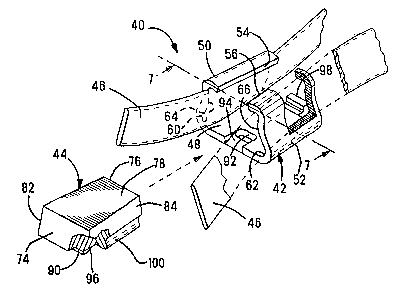Une partie des informations de ce site Web a été fournie par des sources externes. Le gouvernement du Canada n'assume aucune responsabilité concernant la précision, l'actualité ou la fiabilité des informations fournies par les sources externes. Les utilisateurs qui désirent employer cette information devraient consulter directement la source des informations. Le contenu fourni par les sources externes n'est pas assujetti aux exigences sur les langues officielles, la protection des renseignements personnels et l'accessibilité.
L'apparition de différences dans le texte et l'image des Revendications et de l'Abrégé dépend du moment auquel le document est publié. Les textes des Revendications et de l'Abrégé sont affichés :
| (12) Brevet: | (11) CA 2126273 |
|---|---|
| (54) Titre français: | CONNECTEUR ELECTRIQUE |
| (54) Titre anglais: | ELECTRICAL CONNECTOR |
| Statut: | Périmé et au-delà du délai pour l’annulation |
| (51) Classification internationale des brevets (CIB): |
|
|---|---|
| (72) Inventeurs : |
|
| (73) Titulaires : |
|
| (71) Demandeurs : |
|
| (74) Agent: | SMART & BIGGAR LP |
| (74) Co-agent: | |
| (45) Délivré: | 2004-11-23 |
| (22) Date de dépôt: | 1994-06-20 |
| (41) Mise à la disponibilité du public: | 1995-01-30 |
| Requête d'examen: | 2001-06-12 |
| Licence disponible: | S.O. |
| Cédé au domaine public: | S.O. |
| (25) Langue des documents déposés: | Anglais |
| Traité de coopération en matière de brevets (PCT): | Non |
|---|
| (30) Données de priorité de la demande: | ||||||
|---|---|---|---|---|---|---|
|
A connector 10 is disclosed of the type that
interconnects and mechanically secures two electrical
conductors together, particularly non-insulated, flat
ribbon conductors 46. The connector includes a C-shaped
clamping member 42 and a wedge 44 that is conformably
received therewithin thereby forming a conductor
receiving channel on each side of the wedge 44, between
the wedge 44 and the walls of the clamping member 42.
As the wedge 44 is forced into the clamping member 42
the walls are elastically deflect outwardly, applying
substantial force against the conductors, thereby
establishing good electrical contact and a strong
mechanical interconnection of the two conductors. The
connector 10 is self aligning for a variety of conductor
sizes where at least one is a flat conductor. This is
achieved by means of a novel combination of concave and
convex surfaces on the clamping member and a pair of
flat converging surfaces on the wedge, one of which
includes a concave portion.
Note : Les revendications sont présentées dans la langue officielle dans laquelle elles ont été soumises.
Note : Les descriptions sont présentées dans la langue officielle dans laquelle elles ont été soumises.

2024-08-01 : Dans le cadre de la transition vers les Brevets de nouvelle génération (BNG), la base de données sur les brevets canadiens (BDBC) contient désormais un Historique d'événement plus détaillé, qui reproduit le Journal des événements de notre nouvelle solution interne.
Veuillez noter que les événements débutant par « Inactive : » se réfèrent à des événements qui ne sont plus utilisés dans notre nouvelle solution interne.
Pour une meilleure compréhension de l'état de la demande ou brevet qui figure sur cette page, la rubrique Mise en garde , et les descriptions de Brevet , Historique d'événement , Taxes périodiques et Historique des paiements devraient être consultées.
| Description | Date |
|---|---|
| Le délai pour l'annulation est expiré | 2007-06-20 |
| Lettre envoyée | 2006-06-20 |
| Inactive : CIB de MCD | 2006-03-11 |
| Accordé par délivrance | 2004-11-23 |
| Inactive : Page couverture publiée | 2004-11-22 |
| Inactive : Taxe finale reçue | 2004-09-08 |
| Préoctroi | 2004-09-08 |
| Un avis d'acceptation est envoyé | 2004-08-02 |
| Un avis d'acceptation est envoyé | 2004-08-02 |
| Lettre envoyée | 2004-08-02 |
| Inactive : Approuvée aux fins d'acceptation (AFA) | 2004-07-14 |
| Modification reçue - modification volontaire | 2001-10-03 |
| Inactive : Dem. traitée sur TS dès date d'ent. journal | 2001-07-18 |
| Lettre envoyée | 2001-07-18 |
| Inactive : Renseign. sur l'état - Complets dès date d'ent. journ. | 2001-07-18 |
| Toutes les exigences pour l'examen - jugée conforme | 2001-06-12 |
| Exigences pour une requête d'examen - jugée conforme | 2001-06-12 |
| Demande publiée (accessible au public) | 1995-01-30 |
Il n'y a pas d'historique d'abandonnement
Le dernier paiement a été reçu le 2004-03-16
Avis : Si le paiement en totalité n'a pas été reçu au plus tard à la date indiquée, une taxe supplémentaire peut être imposée, soit une des taxes suivantes :
Veuillez vous référer à la page web des taxes sur les brevets de l'OPIC pour voir tous les montants actuels des taxes.
| Type de taxes | Anniversaire | Échéance | Date payée |
|---|---|---|---|
| TM (demande, 4e anniv.) - générale | 04 | 1998-06-22 | 1998-03-24 |
| TM (demande, 5e anniv.) - générale | 05 | 1999-06-21 | 1999-03-23 |
| TM (demande, 6e anniv.) - générale | 06 | 2000-06-20 | 2000-03-22 |
| TM (demande, 7e anniv.) - générale | 07 | 2001-06-20 | 2001-03-23 |
| Requête d'examen - générale | 2001-06-12 | ||
| TM (demande, 8e anniv.) - générale | 08 | 2002-06-20 | 2002-03-22 |
| TM (demande, 9e anniv.) - générale | 09 | 2003-06-20 | 2003-03-19 |
| TM (demande, 10e anniv.) - générale | 10 | 2004-06-21 | 2004-03-16 |
| Taxe finale - générale | 2004-09-08 | ||
| TM (brevet, 11e anniv.) - générale | 2005-06-20 | 2005-06-03 |
Les titulaires actuels et antérieures au dossier sont affichés en ordre alphabétique.
| Titulaires actuels au dossier |
|---|
| THE WHITAKER CORPORATION |
| THE WHITAKER CORPORATION |
| Titulaires antérieures au dossier |
|---|
| GINO MENECHELLA |